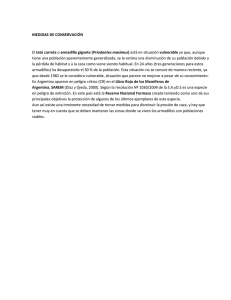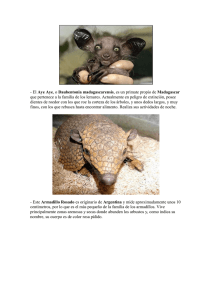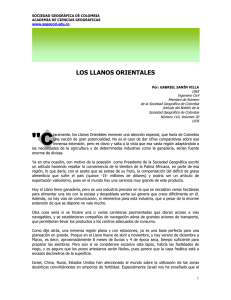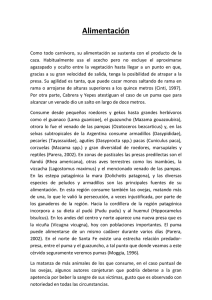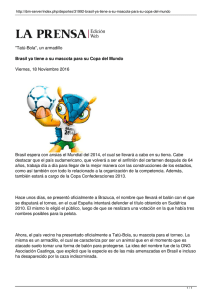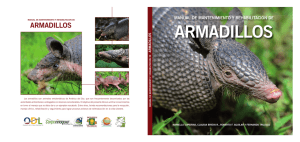Bradypus pygmaeus is now listed in CITES Appendix II The Second
Anuncio
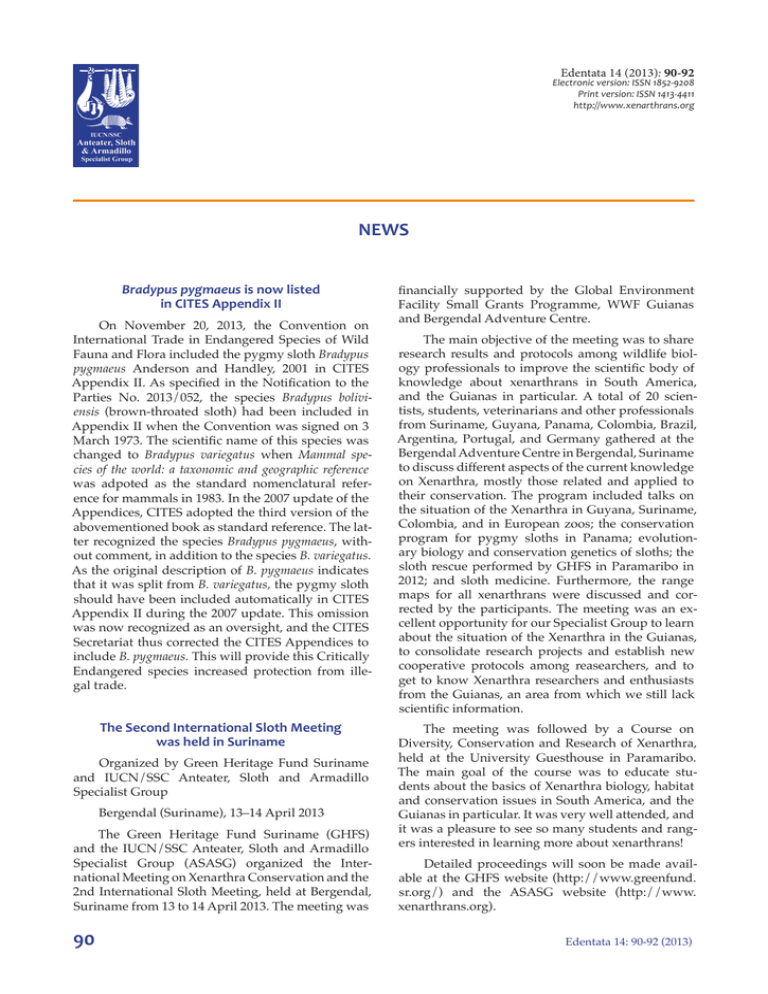
Edentata 14 (2013): 90-92 Electronic version: ISSN 1852-9208 Print version: ISSN 1413-4411 http://www.xenarthrans.org NEWS Bradypus pygmaeus is now listed in CITES Appendix II On November 20, 2013, the Convention on International Trade in Endangered Species of Wild Fauna and Flora included the pygmy sloth Bradypus pygmaeus Anderson and Handley, 2001 in CITES Appendix II. As specified in the Notification to the Parties No. 2013/052, the species Bradypus boliviensis (brown-throated sloth) had been included in Appendix II when the Convention was signed on 3 March 1973. The scientific name of this species was changed to Bradypus variegatus when Mammal species of the world: a taxonomic and geographic reference was adpoted as the standard nomenclatural reference for mammals in 1983. In the 2007 update of the Appendices, CITES adopted the third version of the abovementioned book as standard reference. The latter recognized the species Bradypus pygmaeus, without comment, in addition to the species B. variegatus. As the original description of B. pygmaeus indicates that it was split from B. variegatus, the pygmy sloth should have been included automatically in CITES Appendix II during the 2007 update. This omission was now recognized as an oversight, and the CITES Secretariat thus corrected the CITES Appendices to include B. pygmaeus. This will provide this Critically Endangered species increased protection from illegal trade. The Second International Sloth Meeting was held in Suriname Organized by Green Heritage Fund Suriname and IUCN/SSC Anteater, Sloth and Armadillo Specialist Group Bergendal (Suriname), 13–14 April 2013 The Green Heritage Fund Suriname (GHFS) and the IUCN/SSC Anteater, Sloth and Armadillo Specialist Group (ASASG) organized the International Meeting on Xenarthra Conservation and the 2nd International Sloth Meeting, held at Bergendal, Suriname from 13 to 14 April 2013. The meeting was 90 financially supported by the Global Environment Facility Small Grants Programme, WWF Guianas and Bergendal Adventure Centre. The main objective of the meeting was to share research results and protocols among wildlife biology professionals to improve the scientific body of knowledge about xenarthrans in South America, and the Guianas in particular. A total of 20 scientists, students, veterinarians and other professionals from Suriname, Guyana, Panama, Colombia, Brazil, Argentina, Portugal, and Germany gathered at the Bergendal Adventure Centre in Bergendal, Suriname to discuss different aspects of the current knowledge on Xenarthra, mostly those related and applied to their conservation. The program included talks on the situation of the Xenarthra in Guyana, Suriname, Colombia, and in European zoos; the conservation program for pygmy sloths in Panama; evolutionary biology and conservation genetics of sloths; the sloth rescue performed by GHFS in Paramaribo in 2012; and sloth medicine. Furthermore, the range maps for all xenarthrans were discussed and corrected by the participants. The meeting was an excellent opportunity for our Specialist Group to learn about the situation of the Xenarthra in the Guianas, to consolidate research projects and establish new cooperative protocols among reasearchers, and to get to know Xenarthra researchers and enthusiasts from the Guianas, an area from which we still lack scientific information. The meeting was followed by a Course on Diversity, Conservation and Research of Xenarthra, held at the University Guesthouse in Paramaribo. The main goal of the course was to educate students about the basics of Xenarthra biology, habitat and conservation issues in South America, and the Guianas in particular. It was very well attended, and it was a pleasure to see so many students and rangers interested in learning more about xenarthrans! Detailed proceedings will soon be made available at the GHFS website (http://www.greenfund. sr.org/) and the ASASG website (http://www. xenarthrans.org). Edentata 14: 90-92 (2013) The ultimate book on nine-banded armadillos is now available! Nuevo libro de divulgación sobre los armadillos de los Llanos Orientales The nine-banded armadillo: a natural history by Jim Loughry and Colleen McDonough aims at describing the current knowledge on the biology of nine-banded armadillos. In a logical sequence of 11 chapters, it provides a thorough review of the research that has been done on this species and highlights the gaps that remain to be explored. Although focusing on nine-banded armadillos, this wonderful book also includes data on the other 20 species of armadillos and thus gives an excellent overview over the state of the art of armadillo research. Armadillos de los Llanos Orientales es un libro muy atractivo de divulgación, editado por Fernando Trujillo y Mariella Superina, que aborda uno de los problemas fundamentales que están sufriendo los armadillos: el desconocimiento. En un lenguaje claro, sencillo y con abundantes ilustraciones, a lo largo de 176 páginas introduce al lector al fascinante mundo de los armadillos. El texto empieza con una descripción de las 21 especies de armadillos existentes en el mundo revelando su amplia diversidad morfológica y ecológica, poniendo especial énfasis en las cinco especies presentes en los Llanos Orientales de Colombia. Le sigue un capítulo sobre los armadillos en el mundo indígena y llanero que no solo describe el uso tradicional de estos mamíferos acorazados, sino también incluye muy interesantes creencias y leyendas recabadas de pobladores indígenas. Las características anatómicas, biológicas y ecológicas más sobresalientes de los armadillos son el enfoque de otro capítulo que sin lugar a dudas despertará el interés de los lectores. Las amenazas que enfrentan estos “arquitectos de la naturaleza” en los Llanos Orientales cierran la parte general de este libro para dar lugar a una descripción del Programa de Conservación y Manejo de los Armadillos de los Llanos Orientales. Este último capítulo incluye una presentación de los principales logros de las evaluaciones biológicas, sociales, genéticas, de manejo ex situ y de educación ambiental obtenidos en el transcurso del primer año de vida de esta interesante iniciativa. El libro concluye con un capítulo llamado Armadillos: El Futuro, que insiste en la importancia de dar continuidad y de sumar otros actores al Programa de Conservación y Manejo de los Armadillos de los Llanos Orientales, y da recomendaciones para el largo camino que tiene por delante esta iniciativa. The nine-banded armadillo: a natural history is a major contribution to the field of armadillo research. The usual thinking is that armadillos are poorly known mammals, but this book proves us wrong – at least for the case of the nine-banded armadillo. By compiling all available scientific data on nine-banded armadillos and interpreting them in a broader context, the authors show us that, in fact, we know quite a bit about the biology of this strange mammal, in spite of the limited number of researchers dedicated to exploring the wonders of this odd creature. But, of course, there are still quite a few unknowns about its biology. The authors also stress the gaps in our knowledge and highlight some areas that deserve more attention from the scientific community. Among others, this book provides an extremely useful description on the methodology of doing fieldwork on armadillos. We wish someone had published a chapter like Methods and Madness years ago – it would certainly have saved many of us quite a lot of headache, and its reading should be mandatory for anyone thinking about working with armadillos. The nine-banded armadillo: a natural history includes abundant scientific data, which has been translated by the authors into a language that is easy to understand, but without losing scientific accuracy. The information is presented in a way that is appealing to scientists and armadillo enthusiasts alike. It is a pleasure to read it, as the style is entertaining and stimulating. It makes you want to continue reading and learning more about these odd-looking mammals. We highly recommend it! Loughry, W. J. & C. M. McDonough. 2013. The nine-banded armadillo: a natural history. University of Oklahoma Press, Norman, OK. 323 pp. Hardcover, ISBN 978-0-8061-4310-1 Available at http://www.oupress.com/ECommerce/ Book/Detail/1748/the%20nine%20banded%20armadillo News Armadillos de los Llanos Orientales es parte de la estrategia educativa del Programa de Conservación y Manejo de los Armadillos de los Llanos Orientales. Este Programa, el primero no solo a nivel nacional, sino uno de los más promisorios en América, nació en el año 2012 como un esfuerzo conjunto entre empresa privada, academia, gobierno y comunidad. Actualmente está integrado por la empresa Oleoducto de los Llanos Orientales (ODL), la Fundación Omacha, el Bioparque Los Ocarros 91 y las Corporaciones Ambientales Cormacarena y Corporinoquia. El Programa busca hacer un aporte importante y sostenible a la fauna, al preservar una especie insigne de los Llanos a través, entre otras acciones, de la educación y generación de conciencia en sus habitantes y muy especialmente, en diez mil niños y niñas que serán abanderados de su cuidado y conservación desde ahora y en el futuro. Los editores mencionan que es su anhelo que esta publicación despierte el interés y la curiosidad de los lectores por estos fascinantes animales y motive su investigación y su cuidado para que no los vean desaparecer de Colombia. Sin lugar a dudas, este fascinante libro logrará su objetivo. Para mayor información contactarse con Mariella Superina, E-mail <mariella@superina.ch> o Fernando Trujillo, E-mail <fernando@omacha.org>. Trujillo, F. y M. Superina (eds.). 2013. Armadillos de los Llanos Orientales. ODL, Fundación Omacha, Cormacarena, Corporinoquia, Bioparque Los Ocarros. Bogotá. 176 pp. ISBN 978-958-8554-31-0 Novo livro sobre manutenção de tamanduás em cativeiro! Manutenção de tamanduás em cativeiro, cuidadosamente produzido e editado é um guia completo, didático, atualizado e útil a respeito destas famílias de animais, com esperança de alcançar o máximo de impacto acerca dos tamanduás em cativeiro e beneficiar aqueles que persistem em estado selvagem, apesar das pressões que exercem a perda de habitat, os efeitos das estradas, incêndios e a caça ilegal na sua população geral. Através deste volume, tem-se conseguido elaborar um verdadeiro resumo e guia de um grupo de animais tão interessantes como desafiadores... Não há melhor maneira de dizê-lo: este livro é essencial para qualquer pessoa que lide, trate, estude ou tenha interesse nestes animais fascinantes. Para maior informação, contatar a <contato@ tamandua.org>. Miranda, F. (ed.) 2012. Manutenção de tamanduás em cativeiro. Editora Cubo, São Carlos, Brazil. ISBN 978-85-60064-27-4 92 Edentata 14: 90-92 (2013)
